The game of black and white - Weiqi
Updated: 2011-06-21 15:59
(China.org.cn)
|
|||||||||||
How to play Weiqi
The game of weiqi is played on a board as shown in Figure 1. The weiqi set is comprised of a board with 180 black and white pieces each. The picture below shows the standard 19x19 board, which means the board has 19 lines by 19 lines. There are also 13x13 and 9x9 boards in play. However, the 9x9 and 13x13 boards are usually for beginners; more advanced players would prefer the traditional 19x19 board.
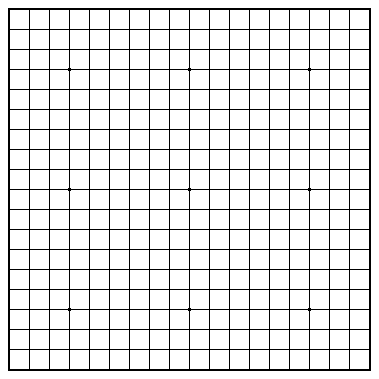
The rules of weiqi are very simple but there are plenty of choices in moving the game pieces with countless variations of strategies. This is where the charm of the game lies. The amount of time it takes for one round of weiqi can be as short as 15 minutes or as long as a few days. In most cases, it takes one or two hours to finish one round. Several rule sets exist and are commonly used throughout the world. Two of the most common are Chinese rules and Japanese rules.
Getting Started
A weiqi game is started with an empty board. Pieces are placed on the intersections of the board. The player holding black pieces makes the first move and each player places a piece on the board on his or her turn. Players are free to place their pieces at any unoccupied intersections on the board.
Once the pieces are placed on the board, they are not to be moved to another location. The pieces are not to be removed from the board. Players are not allowed to stack a piece on top of another piece on the board. These are the rules that make weiqi unique compared to most other board games; the beauty of weiqi also lies in the simplicity of its rules.
Liberties
|
 |
 |
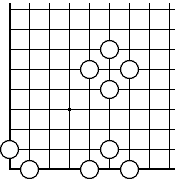 |
| Figure 2 | Figure 3 | Figure 4 |
Liberties refer to the unoccupied intersections (or points) that are horizontally or vertically adjacent to a piece. Note: points diagonally next to a piece are not liberties of that piece. Liberties of the three black pieces are marked as X in Figure 2. A piece in the middle has four liberties; a piece at the side has three liberties; a piece at the corner has two liberties.
The rule says pieces without liberties must be removed from the board. For example, in Figure 3, the three black pieces have no liberties and therefore they must be removed from the board as shown in Figure 4. However, the reverse is also true: pieces with at least one liberty must remain on the board.
Making a move that causes your pieces (but not your opponent’s) to have no liberties is known as suicide. Usually suicide is forbidden, but some variations of the rule allow for suicide, whereby the suicide move causes the pieces without liberties to be removed from the board and it is the opponent’s turn to play.
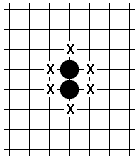 |
| Figure 5 |
A chain consists of two or more pieces that are connected to each other horizontally or vertically, but not diagonally. The liberties of a chain are counted together as a unit. An example is Figure 5, where the two black pieces have a combined total of six liberties marked X. When white has played at all the positions marked X, such that the two black pieces have no liberties at all, and then white will remove the two pieces together. At no time is white allowed to remove any of the two pieces individually.
|
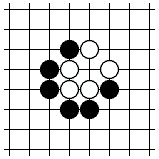 |
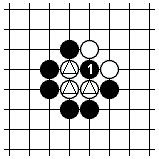 |
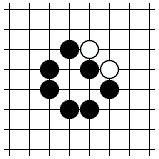 |
| Figure 6 | Figure 7 | Figure 8 |
Let’s take a look at Figure 6. What if black decides to play at 1 as shown in Figure 7? Notice that the black piece marked 1 has no liberties, but the three white pieces (marked with triangle) have no liberties either. This rule determines the result: the player that causes pieces of both players to have no liberties will have his opponent’s pieces removed. Hence, black will remove the three white pieces, with the end result shown in Figure 8.